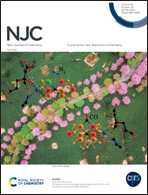Identification of natural flavonoids as novel EGFR inhibitors using DFT, molecular docking, and molecular dynamics†
Abstract
Epidermal growth factor receptor (EGFR) is a tyrosine kinase receptor that causes different types of cancers on its overexpression or mutation and rearrangement or amplification of the EGFR gene. Inhibition of EGFR is one of the popular cancer treatment techniques. The approved EGFR inhibitors have savior side effects. A good number of natural products have been discovered every year. Finding a lead molecule from this huge natural product library is not only challenging but also the most important job. Structural similarity to well-known EGFR inhibitors, their binding modes, and their mechanisms of action can provide a way to choose new lead natural products for their better alternatives. In this work, quantum mechanical descriptors from DFT, molecular docking, and NCIplot methodology were utilized to find a potential anti-EGFR flavonoid. Rhamnocitrin derivative Tupichinols E (10) obtained from southern Chinese plant Tupistra chinensis shows the best results. Tupichinols E has 1.4 times more binding ability than osimertinib (third-generation EGFR tyrosine kinase inhibitors (TKIs)). The compound binds at the exact position of osimertinib in the crystal structure of EGFR and has similar poses. In addition to this, a plot of pIC50 of EGFR-TKIs against their binding score obtained from their docking with the protein shows that all fifteen compounds have good to excellent binding affinity with EGFR TK. The binding of Tupichinols E with EGFR TK can stabilise the protein structure, which is evident from 100 ns molecular dynamics simulation.



 Please wait while we load your content...
Please wait while we load your content...